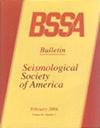综合故障系统反演方法:方法及在 NSHM 中的应用23
IF 2.9
3区 地球科学
Q2 GEOCHEMISTRY & GEOPHYSICS
引用次数: 2
摘要
我们为 2023 年更新的国家地震危险性模型(NSHM23)提出了基于反演的最新断层系统解决方案,使美国西部地壳断层的地震率模型计算标准化。我们借鉴了第三次加利福尼亚地震破裂统一预测(UCERF3)中使用的反演方法,以求解相互连接的断层系统中与时间无关的地震率。更新后的模型明确映射了各种断层复发和分段行为(认识不确定性),更全面地探索了 UCERF3 以外可行模型的求解空间。我们还改进了模拟退火的实现,大大提高了计算效率(从而提高了反演收敛性),并引入了一种自适应约束权重计算算法,有助于在相互竞争的约束之间进行调解。灾害计算显示,成分变化(尤其是断层和变形模型)是NSHM23和UCERF3之间灾害变化的主要驱动因素。在 UCERF3 中滑动率拟合不佳或主要使用大型多断层破裂来满足要求的断层附近,反演方法的更新也产生了影响,这些断层现在受到明确的 b 值和分段约束的限制。本文章由计算机程序翻译,如有差异,请以英文原文为准。
A Comprehensive Fault-System Inversion Approach: Methods and Application to NSHM23
We present updated inversion-based fault-system solutions for the 2023 update to the National Seismic Hazard Model (NSHM23), standardizing earthquake rate model calculations on crustal faults across the western United States. We build upon the inversion methodology used in the Third Uniform California Earthquake Rupture Forecast (UCERF3) to solve for time-independent rates of earthquakes in an interconnected fault system. The updated model explicitly maps out a wide range of fault recurrence and segmentation behavior (epistemic uncertainty), more completely exploring the solution space of viable models beyond those of UCERF3. We also improve the simulated annealing implementation, greatly increasing computational efficiency (and thus inversion convergence), and introduce an adaptive constraint weight calculation algorithm that helps to mediate between competing constraints. Hazard calculations show that ingredient changes (especially fault and deformation models) are the primary driver of hazard changes between NSHM23 and UCERF3. Updates to the inversion methodology are also consequential near faults in which the slip rate in UCERF3 was poorly fit or was satisfied primarily using large multifault ruptures that are now restricted by explicit b-value and segmentation constraints.
求助全文
通过发布文献求助,成功后即可免费获取论文全文。
去求助
来源期刊

Bulletin of the Seismological Society of America
地学-地球化学与地球物理
CiteScore
5.80
自引率
13.30%
发文量
140
审稿时长
3 months
期刊介绍:
The Bulletin of the Seismological Society of America, commonly referred to as BSSA, (ISSN 0037-1106) is the premier journal of advanced research in earthquake seismology and related disciplines. It first appeared in 1911 and became a bimonthly in 1963. Each issue is composed of scientific papers on the various aspects of seismology, including investigation of specific earthquakes, theoretical and observational studies of seismic waves, inverse methods for determining the structure of the Earth or the dynamics of the earthquake source, seismometry, earthquake hazard and risk estimation, seismotectonics, and earthquake engineering. Special issues focus on important earthquakes or rapidly changing topics in seismology. BSSA is published by the Seismological Society of America.
 求助内容:
求助内容: 应助结果提醒方式:
应助结果提醒方式:


